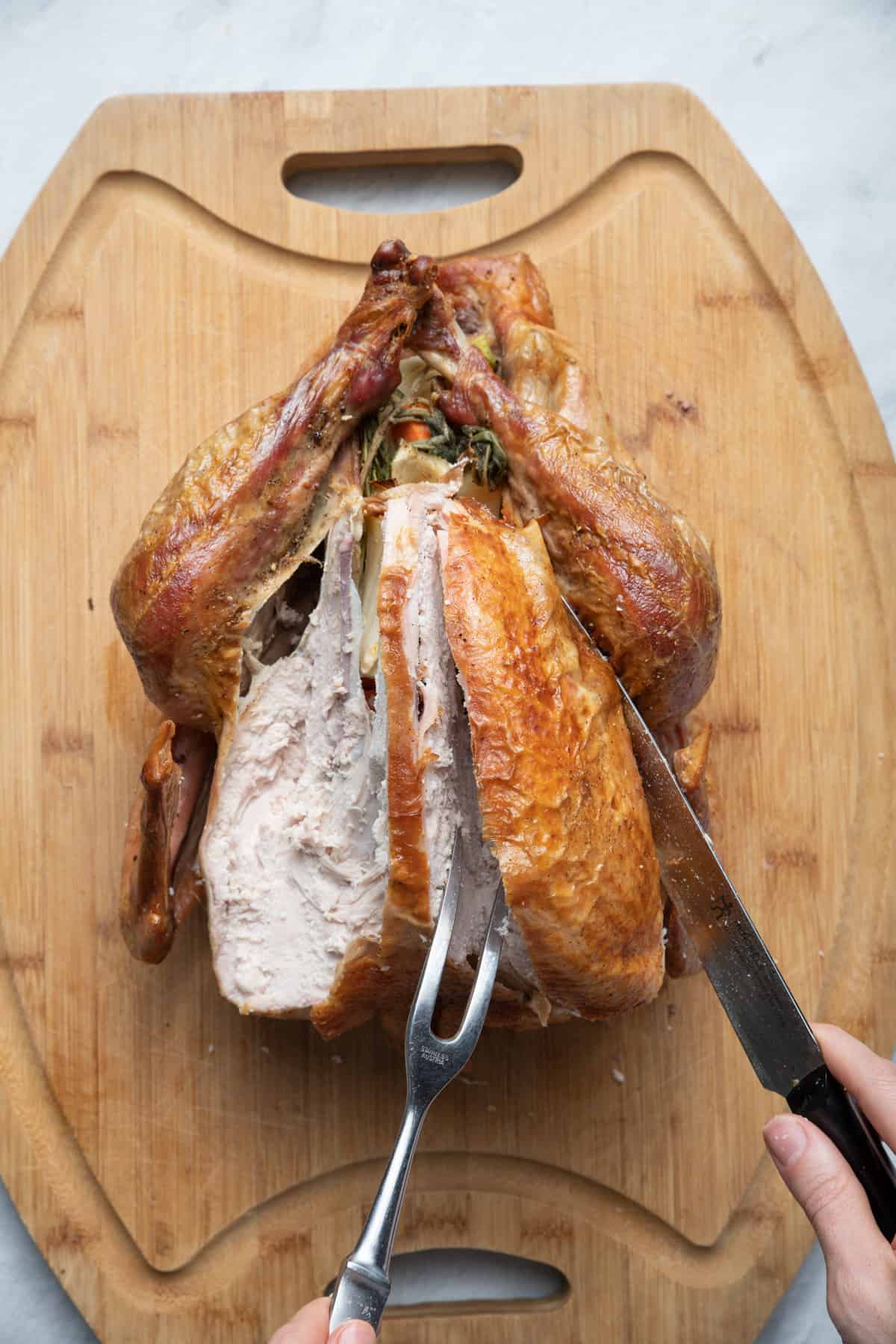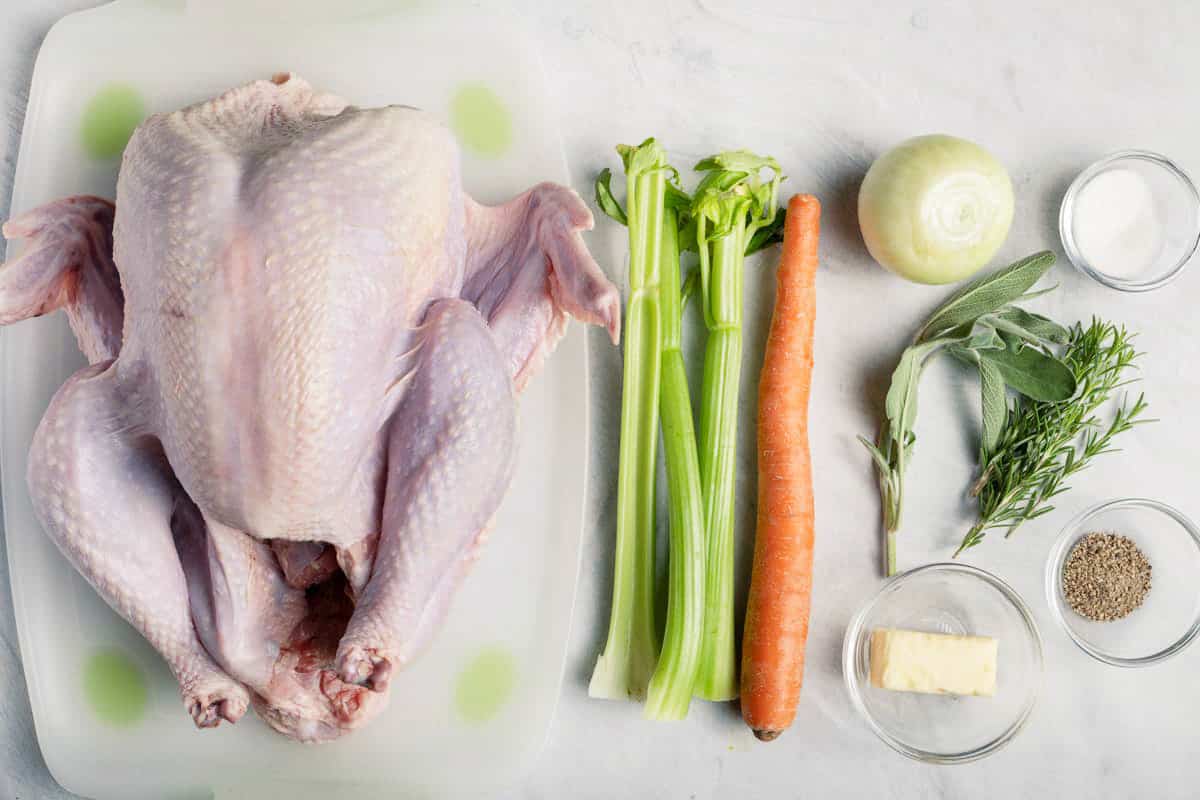While traditional stuffing holds a special place in our Thanksgiving hearts, there’s a whole world of possibilities beyond the bread-based classic. So, what else can you tuck into your turkey to add flavor and moisture? Let’s explore some delicious and creative options:
Aromatic Vegetables:
- Onions: Halved onions add a sweet and savory depth to the turkey, while also releasing steam to keep the meat moist.
- Carrot Chunks: These add a touch of sweetness and a vibrant color to the cavity.
- Celery Stalks: Celery infuses the turkey with a subtle celery flavor and helps keep it moist.
- Fresh Herbs: Rosemary, thyme, sage, and parsley sprigs add a fragrant, herbaceous aroma to the bird.
Fruity Delights:
- Apple Quarters: Apples infuse the turkey with a touch of sweetness and a hint of tartness.
- Citrus Wedges: Lemon, lime, orange, or grapefruit wedges add a bright and refreshing flavor to the meat.
- Dried Fruits: Cranberries, raisins, or chopped dates add a chewy texture and a burst of sweetness.
Savory Surprises:
- Garlic Cloves: Whole or halved garlic cloves add a pungent and aromatic flavor to the turkey.
- Ginger Slices: Fresh ginger adds a warm and spicy kick to the bird.
- Chiles: For a touch of heat, stuff the cavity with whole or sliced chiles.
Beyond the Basics:
- Mirepoix: This classic French combination of chopped onions, carrots, and celery adds a rich and savory flavor to the turkey.
- Mushrooms: Cremini, portobello, or shiitake mushrooms add a umami depth and a meaty texture.
- Sausages: Italian sausage, chorizo, or andouille sausage add a bold and spicy flavor to the stuffing.
- Nuts: Chopped almonds, walnuts, or pecans add a crunchy texture and a nutty flavor.
Additional Tips:
- Loosely fill the cavity: Don’t overstuff the turkey, as this can hinder even cooking.
- Pre-cook raw ingredients: If using raw meat, poultry, or seafood, cook them beforehand to ensure food safety.
- Consider cooking the stuffing separately: This ensures even cooking and eliminates the risk of undercooked stuffing.
- Use a food thermometer: Check the internal temperature of the stuffing and the turkey to ensure they reach 165°F before serving.
Get Creative!
Don’t be afraid to experiment and try new combinations. The possibilities are endless! Remember, the goal is to add flavor, moisture, and a touch of your personal flair to your Thanksgiving turkey.
Happy Thanksgiving!
Carving Your Turkey: A Step-by-Step Guide
- Cutting: Hold the turkey so that its neck end is closest to you. First, make a horizontal incision above the wing joint at the base of the breast and cut all the way through to the bone.
- To remove the breasts, run a knife along the breastplate’s outline and move it down each side of the rib cage in the direction of the wing joint. As you cut, carefully pull the breast meat away to enable a clean separation.
- Leg Detachment: Press down on the drumsticks until they snap outward, exposing the joint. With ease, cut through the joint to free the legs from the body.
- Wing Separation: To separate the wings from the body, locate the skin that connects the wings and cut it gently.
- Breast Slicing: Place the skin-side up breast meat on a chopping board. For maximum tenderness, cut it into even slices against the grain and arrange them on your serving dish.
- Thigh and Drumstick Division: To identify the joint seam, turn the thigh and drumstick combination skin-side down. To separate the thigh from the drumstick, cut through this seam. To remove the thigh bone and preserve the delicious thigh meat, trim along its length.
- Thigh Slicing: Using the same against-the-grain technique to create a more textural effect, slice the thigh meat on the cutting board and transfer the slices to your serving dish. Position the drumsticks next to the slices.
- Wing Jointing: Locate the joint joining the drumette and wingtip. Cut through this joint to release the two sections, then incorporate them into your serving configuration.
- Final Trimmings: Check the turkey carcass for any leftover meat, paying close attention to any crevices. To guarantee that nothing goes to waste, cut off these pieces and place them on your platter.

Ingredients to make a Thanksgiving turkey
- Turkey: Buy the best quality turkey you can. Before stuffing and seasoning it, cut off the neck, giblets, and truss it. Use a turkey that weighs approximately 15 pounds for the best results with this cooking method.
- Chopped carrot, celery, and onion are inserted inside the cavity. These keep the turkey moist while steaming and contribute flavor. Other vegetables you can use are squashes or peppers.
- Seasonings & Herbs: Salt, pepper, fresh rosemary and sage.
- Butter: Melted butter is brushed both on top of and in between the turkey’s skin and meat. This keeps the turkey juicy and helps achieve a nice, crispy, browned skin. Try using avocado oil instead of butter if you’d rather not use it.

How to Make Easy Beginner’s Turkey with Stuffing | Thanksgiving Recipes | Allrecipes.com
FAQ
What to stuff a turkey with besides stuffing?
Besides stuffing, you can put aromatic ingredients like onions, garlic, herbs (such as rosemary, thyme, or sage), citrus slices (lemon or orange), and vegetables (carrots, celery) inside your turkey to add flavor during roasting. Remember to remove these ingredients before serving.
What is good to stuff a turkey?
Alliums: Add quartered onions, shallots, leeks, or garlic cloves for a delicious, earthy aroma. Fruits: Insert quarters of apple, lemon, orange, lime, or even grapefruit to add moisture and brightness to the turkey. You can even go with dried fruit, like cranberries, to double down on the autumn vibes.
What do you put inside the cavity of a turkey?
Onion, celery and carrot: These chopped vegetables are placed inside the cavity. These help to add flavor and also keep the turkey moist as they steam. Other vegetables you can use are squashes or peppers. Seasonings & Herbs: Salt, pepper, fresh rosemary and sage.
Does stuffing a turkey keep it moist?
The primary advantages to in-bird stuffing are that it’s unbelievably moist and looks super-Thanksgiving-y, but to be safe (with the raw eggs in the stuffing and the raw turkey touching it), you need to cook it to 165 degrees F, which means the bird’s going to have to cook to an even higher temperature, which means a …
